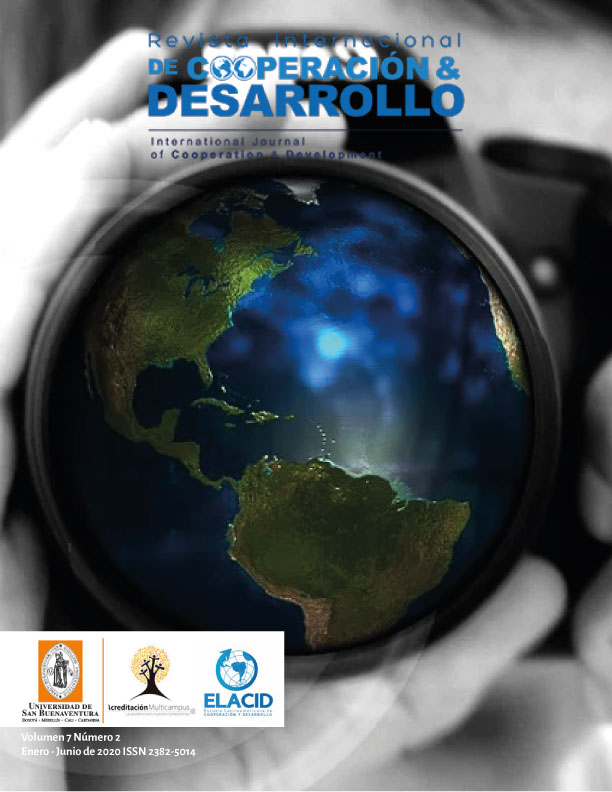INTERNATIONAL JOURNAL OF COOPERATION AND DEVELOPMENT
Assignment of Rights
Authorization for reproduction, publication, communication and distribution of a literary, artistic or scientific
Work.
I , ____________________________________________, author of the book and / or article , of legal age , resident of the city of _________________ , identified with citizenship / passport n° ______________________ issued on _______________________, in exercise of his physical and mental faculties , part henceforth be called the AUTHOR , supports the following authorization to the reproduction, publication, communication and distribution of a work, perform the following terms:
1. Regardless of current legal regulations due to the linking of the parties to this contract, and any kind of legal presumption , the parties agree that the AUTHOR authorize ( name of the publisher ) to reproduce , publish , communicate and distribute the material referred to in the International Journal of Cooperation and Development of the University of San Buenaventura.
2. Such authorization lies in particular on the copyright of the work, by any means known or unknown, publication of the work, distribution of the work , either directly or through third parties for purely educational purposes.
3. AUTHOR agrees to report and declare the existence of this authorization and to preserve the right of the International Journal of Cooperation and Development of the first publication of the work.
4. AUTHOR declares that the article is original and that it is his sole creation, no impediment of any kind exist for the authorization he is doing, besides being responsible for any action claim, plagiarism or other type of claim that might arise about .
5. Such permission is free of charge.
6. Moral copyright in the article are solely the AUTHOR and the University of San Buenaventura expressly agrees to recognize and respect them rigorously.
The Author and / or AUTHORS
SIGNATURE
Abstract
Este artículo tiene como objetivo analizar las implicaciones de la "Política de Una China" y para la cooperación internacional para el desarrollo y la entrega de ayuda exterior de China y Taiwán los países de América Latina y del Caribe (ALC). Aunque desde la expulsión de Taipéi de la ONU en 1971 la mayoría de los países de ALC han reconocido a Beijing como el único gobierno legítimo de toda China, la política de “Una Sola China” sigue siendo central en ALC, ya que un poco más de la mitad (nueve sobre quince) de los países que continúan manteniendo relaciones diplomáticas con Taiwán se encuentran en esta región. En las últimas décadas, ambos países han llevado a cabo una especie de “diplomacia de la chequera” para ganar aliados a cambio de la entrega de asistencia para el desarrollo. En particular, desde 2016, Beijing ha retomado su ofensiva diplomática para el reconocimiento en ALC, logrando que Panamá, El Salvador y la República Dominicana establecieran relaciones formales con China y las rompieran con Taiwán. Mientras que para los países de la región más grandes y con más relaciones comerciales con China es conveniente establecer relaciones oficiales con China, para los países más pequeños puede ser una mejor estrategia reconocer diplomáticamente a Taiwán para beneficiarse de sus generosos programas de ayuda para el desarrollo.
Palabras clave: China; Taiwán; escuela inglesa; socialización; Cooperación internacional; desarrollo; ayuda exterior; América Latina; Caribe.
References
Bonilla, A., y Milet, P. (2015). China en América Latina y el Caribe: Escenarios estratégicos subregionales. FLACSO, CAF.
Bräutigam, D. (2008). China’s African Aid: Transatlantic Challenges. The German Marshall Fund of the United States.
Bräutigam, D. (2009). The dragon’s gift: the real story of China in Africa. Oxford University Press.
Bräutigam, D. (2010). China, Africa and the international aid architecture. African Development Bank Group, Working Paper Series.
Buzan, B. (2004). From international to world society?: English school theory and the social structure of globalisation. Cambridge University Press.
Bull, H. (2012). The anarchical society: a study of order in world politics. Macmillan International Higher Education (original published in 1977).
Chan, G. (1997). Taiwan as an emerging foreign aid donor: developments, problems, and prospects. Pacific Affairs, 70(1), 37-56.
Chan-Fishel, M., & Lawson, R. (2007). Quid pro quo? China’s investment-for-resource swaps in Africa. Development, 50(3), 63-68.
Chen, J. (2002). Foreign policy of the new Taiwan: Pragmatic diplomacy in Southeast Asia. Edward Elgar Publishing.
Cheng, T. Y. (1994). Foreign aid in República de China diplomacy. In B. Lin., & J., Myers. (eds.), Contemporary China and the changing international community (pp. 170-84). University of South Carolina Press
Cheng, S., Fang, T., & Lien, H. T. (2012). China’s international aid policy and its implications for global governance. Research Center for Chinese Politics and Business Working Paper.
Copper, J. F. (2002). Taiwan in Troubled Times: essays on the Chen Shui-bian presidency. World Scientific.
Copper, J. F. (2019). China Diplomacy: The Washington-Taipei-Beijing Triangle. Routledge.
Development Reimagined (2019, September 26). Countries along the Belt and Road- What does it all mean? https://developmentreimagined.com/2019/09/26/countries-along-the-belt-and-road-what-does-it-all-mean/
Ellis, R. E. . (2009). China in Latin America: the whats and wherefores. Lynne Rienner Publishers.
Ellis, R. E. . (2011). Chinese soft power in Latin America: A case study. National Defense Univ Washington Dc.
Ellis, R. E. (2018a). Taiwan’s Diplomatic Struggle in Latin America. The News Lens. Available at: https://international.thenewslens.com/article/109817
Ellis, R. E.. (2018b, june 13). PRC Engagement in Latin America and Implications for Taiwan and the United States. Global Taiwan Brief, 3(12).
Esteban, M. (2007). The diplomatic battle between Beijing and Taipei in Latin America and the Caribbean. Chinese (Taiwan) Yearbook of International Law and Affairs, 25(1), 65-88.
Gerring, J. (2012). Mere description. British Journal of Political Science, 42(4), 721-746.
Goldstein, S. M., & Schriver, R. (2001). An uncertain relationship: The United States, Taiwan and the Taiwan relations act. China Q. https://heinonline.org/HOL/LandingPage?handle=hein.journals/chnaquar42&div=11&id=&page=
Gschwend, T., & Schimmelfennig, F. (2007). Introduction: Designing research in political science - A dialogue between theory and data. In D. Toshkov (ed.), Research Design in Political Science (pp. 1-18). Palgrave Macmillan.
Hernández, J. (2016, june 25). China suspends diplomatic contact with Taiwan. New York Times. https://www.nytimes.com/2016/06/26/world/asia/china-suspends-diplomatic-contact-with-taiwan.html
Hickey, D. (1994). Coming In From The Cold-Taiwan Return To International Organizations. Issues & Studies, 30(10), 94-107.
h En Ferdinand, P. (Ed.). Take-off for Taiwan? (pp. 66-106). Thomson Learning. Hsieh, C. (1985). Strategy for survival: The foreign policy and external relations of the Republic of China on Taiwan, 1949-79. Sherwood Press.
Huang, C. (2016). Triangular Timeline 1885–2015. In B., Womack, & Y., Hao, (eds.). Rethinking The Triangle: Washington-Beijing-Taipei . World Scientific.
Huang, M., & Ren, P. (2012). China’s foreign aid and its role in the international aid architecture. In G. Carbonnier (ed.), International Development Policy: Aid, Emerging Economies and Global Policies (pp. 75-88). Palgrave Macmillan.
Koleski, K. & Blivas, A. (2018). China’s Engagement with Latin America and the Caribbean. U.S.-China Economic and Security Review Commission.
Lee, W. C. (1993). Taiwan’s Foreign Aid Policy. Asian Affairs, 20(1), 43-62.
Lee, W. C. (1994). República de China’s foreign aid policy. In J. C. Hu (ed.), Quiet Revolutions on Taiwan (pp. 331-60). Kwang Hwa Publishing Company.
Lee, W. C. (2004). Field of Dreams: An Overview of the Practice and Study of Taiwan. Issues & Studies, 40(3&4), 137-182.
Lin, B. (1990). The Republic of China and Africa: a case of positive adaptation. In Y. Wang. (ed.), Foreign Policy of the Republic of China on Taiwan: An Unorthodox Approach. Praeger.
Liu, P. (2009). Planting Rice on the Roof of the UN Building: Analysing Taiwan’s “Chinese” Techniques in Africa, 1961- present. The China Quarterly, (198), 381-400.
Lönnqvist, L. (2008). China’s Aid to Africa: Implications for civil society’. Policy Briefing Paper.
Maggiorelli, L. (2017). Chinese aid to Latin America and the Caribbean: Evolution and prospects. Revista Internacional de Cooperación y Desarrollo, 4(2), 28-50.
Maggiorelli, L. (2019a). Taiwan’s development aid to Latin America and the Caribbean and the One China policy. Razón Crítica, (7), 177-208.
Maggiorelli, L. (2019b). Ayuda china y otros flujos oficiales hacia América Latina y el Caribe. Papel Político, 24(2), 1-20.Maggiorelli, L.
Maggiorelli, L. (2020). La progresión de la relación entre Taiwán y América Latina. Manuscrito no publicado.
Mattlin, M., & Nojonen, M. (2015). Conditionality and path dependence in Chinese lending. Journal of Contemporary China, 24(94), 701-720.
Mawdsley, D. (2012). From recipients to donors: emerging powers and the changing development landscape. Zed Books Ltd.Mejía, L. (2010). El Galeón de Manila. La ruta transpacífica. Arqueología Mexicana, 18(105), 34-38.
McCormick, D. (2008). China & India as Africa’s new donors: The impact of aid on development. Review of African political economy, 35(115), 73-92.
Mitton, R. (2006, december 22). Beijing Refuses Aid to Hanoi after Rebuff over Taiwan. Strait Times.
Möller, K. (1996). Does Flexible Diplomacy Improve Taiwan’s International Status? In J. Henckaerts. (ed.), The International Status of Taiwan in the New World Order: Legal and Political Considerations (pp. 53-62). Kluwer International Law
MOFA. (2020). Ministry of Foreign Affairs. 中華民國外交部 - 全球資訊網英文網. https://www.mofa.gov.tw/
NPC. (2007). Preamble. In Constitution of the People’s Republic of China. National People’s Congress of the People’s Republic of China. http://www.npc.gov.cn/zgrdw/englishnpc/Constitution/2007-11/15/content_1372962.htm
OCDE. (2020). Official development assistance (ODA) - Net ODA - OECD Data. https://data.oecd.org/oda/net-oda.htm
ONU. (1971). Restoration of the lawful rights of the People’s Republic of China in the United Nations: resolution / adopted by the General Assembly, A/L.630 and Add.1-2. https://undocs.org/en/A/RES/2758(XXVI)
Østergaard, C. S. (1993). Values for money? Political conditionality in aid‐The case of China. The European Journal of Development Research, 5(1), 112-134
Pehnelt, G. (2007). The political economy of China’s aid policy in Africa. Jena Economic Research Papers, (2007-051).
Ramos, A. (2017, august 9). Taiwan Gives Guatemala Over Us$600 Million in Funding. Amandala.
Rich, T. (2009). Status for Sale: Taiwan and the Competition for Diplomatic Recognition, Issues & Studies, 45(4), 159-188.
Rich, T. & Dahmer, A. (2017, s). Taiwan’s Central America Dilemma. Taiwan Sentinel. https://sentinel.tw/taiwans-central-america-dilemma/
Rubinstein, M. (1999). Political Taiwanization and pragmatic diplomacy: The eras of Chiang Ching-kuo and Lee Teng-hui, 1971-1994. In Taiwan: A new history (pp. 436-80). M.E. Sharpe.
Schimmelfennig, F., Engert, S., & Knobel, H. (2006). International socialization in Europe: European organizations, political conditionality and democratic change. Springer.
Shelton, J. (2014). Conditionality and the ambitions of governance: Social transformation in Southeastern Europe. Springer.
Su, C. (2003). 危險邊緣: 從兩國論到一邊一國Weixian bianlu: liang guo lun dao yi bian yi guo [Brinkmanship: From Two States Theory to One Country Each Side] Taipei: Tianxia wenhua.
Taylor, I. (1998). China’s foreign policy towards Africa in the 1990s. The Journal of Modern African Studies, 36(3), 443-460.
Tierney, M., Nielson, D., Hawkins, D., Roberts, J., Findley, M., Powers, R., & Hicks, R. (2011). More dollars than sense: Refining our knowledge of development finance using AidData. World Development, 39(11), 1891-1906.
Tudoroiu, T. (2019). The Myth of China’s No Strings Attached Development Assistance: A Caribbean Case Study. Lexington Books.
Varrall, M. (2016). Domestic actors and agendas in Chinese aid policy. The Pacific Review, 29(1), 21-44.
Wang, C. (1995). The Republic of China’s Foreign Policy 1949-1988: Factors Affecting Change in Foreign Policy Behavior. University Microfilms International.
Kjøllesdal, K., Analysebyrå, C., & Welle-Strand, A. (2010). Foreign Aid Strategies: China Taking Over?. Asian Social Science, 6(10), 3-13.
Williams, G. (1999). The Prize of all the Oceans: The Dramatic Story of Commodore Anson’s Voyage Around the World and How he Seized the Spanish Treasure Galleon. Viking.
Woods, N. (2008). Whose aid? Whose influence? China, emerging donors and the silent revolution in development assistance. International affairs, 84(6), 1205-1221.
Wu, L. J. (1995). Does money talk? The República de China’s economic diplomacy. Issues & studies, 31(12), 22-35.
Xinhua. (2016). Full text of China’s Policy Paper on Latin America and the Caribbean. China.org. http://www.china.org.cn/world/2016-11/24/content_39777989.htm















